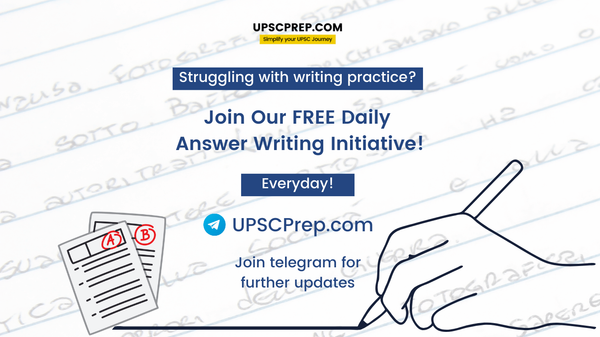Subject: GS 2
Syllabus: Issues Relating to Development and Management of Social Sector/Services relating to Health, Education, Human Resources.
Issues relating to Poverty and Hunger.
Questions
- The socio-economic benefits of Universal Health Coverage are plenty, but for it to be a reality the government must learn core lessons from pandemics and rebuild trust in public health. Comment. (250 Words, 15 Marks)
- E-governance is not only time saving but also citizen friendly which ushers in participatory democracy. Discuss the importance of e-governance and the challenges involved. (150 Words, 10 Marks)
Model Structure
1. The socio-economic benefits of Universal Health Coverage are plenty, but for it to be a reality the government must learn core lessons from pandemics and rebuild trust in public health. Comment. (250 Words, 15 Marks)
Model Structure
Introduction:
- India with mass poverty, geographically distant communities, absence of healthcare infrastructure and shortage of healthcare professionals, needs a robust universal health coverage programme.
Main Body:
Socio-Economic benefits of Universal Healthcare Coverage
- Social:
- Enhance accessibility: every individual should have access to services that address the causes of disease and death.
- Improve health: UHC ensures that quality of health services are good enough leading to improved health of people
- Formation of human capital: affordable and good quality health services to women, children, adolescents and people suffering from mental health issues, would enhance human capital.
- Economic:
- Reduction of financial distress: it protects people from spending on healthcare services out of their own pockets.
- Reduction of poverty: it will cut down the risk of people being pushed into poverty due to huge amounts of spending on unexpected diseases.
- Economic development: In the long run, good health will allow children to learn and adults to earn.
- Building a foundation of economic development in the country.
To provide UHC-core lessons of the pandemic
- Human Resources:
- Shortage of healthcare professionals: especially in rural and small cities.
- Only 45 doctors per lakh population are available, against WHO recommendation of 100.
- Compulsory Rural Stint: To enhance availability and accessibility.
- Maharashtra’s step to stop doctors avoiding rural stint after paying 10 lakhs fine.
- Shortage of healthcare professionals: especially in rural and small cities.
- Affordability:
- Price Regulation: Need to regulate rates and quality in the private sector.
- Insurance coverage: Increase insurance penetration and also the spectrum of treatments covered and PMJAY’s hospital coverage.
- Decrease out of pocket expenditure: Report by Pew Research Center states that the pandemic pushed 32 million out of the middle class.
- Structural changes:
- Increase vaccination infrastructure: to tackle mass vaccination on lines of Polio eradication programme.
- Network of laboratories: Robust testing infrastructure, with hub and spoke model.
- WHO’s framework of six healthcare system building blocks: Study the lessons learnt post pandemic and create actionable points.
- Innovative Approach:
- Behavioral change campaigns: On lines of Swachh Bharat Mission to instill hygiene habits like hand washing.
- Focus on NCDs: NCD burden was highlighted by comorbid complications of COVID-19. They account for 2/3rd deaths in India.
- Technology leverage: Tele-medicine, mobile-health, and digital platforms should be used for healthcare delivery at remote locations.
Steps to rebuild trust in healthcare:
- Increase public spending on health: By at least 3% by 2024.
- Expand healthcare workforce: multilayered, multi skilled teams that can deliver the needed services must be made available.
- Address regional disparities: incentivising rural areas for healthcare infrastructure.
- Reduce out-of-pocket expenditure: essential drugs and diagnostics at public health care facilities should be made free, especially in rural areas.
Conclusion
- In the pandemic era, it is the public system, with all its problems, that has risen to the occasion.
- There is a need to transform the fractured healthcare to a single healthcare system for everyone involving both public and private sectors.
2. E-governance is not only time saving but also citizen friendly which ushers in participatory democracy. Discuss the importance of e-governance and the challenges involved. (150 Words, 10 Marks)
Model Structure
Introduction
- E-governance is the application of information and communication technology to bring in more efficiency, transparency, accountability and accessibility in governance.
- The World Bank defines e-governance as the use of information technology which can transform government relations with businesses and citizens, and also at an intra-governmental level.
Main Body
- Importance of e-governance
- It has enabled swift transfer of information with better data storage and retrieval systems for all the stakeholders involved like citizens, businesses, governments etc. Eg. Bhoomi Project (Karnataka), MCA21 Portal.
- More digital penetration means more awareness among citizens and more use of their rights for vibrant and functioning democracy. Eg. Awareness about PDS after mandatory biometric verification.
- It enables bypassing of red tapism, delays and complex approvals which affect smooth functioning of the governance process. Eg. Setu Suvidha Kendra
- There is a feedback system like in case of citizen charter by which organizations and authorities know what improvements need to be done in line with changing times and demands. Eg. myGov portal
- A lot of government procurement for office work goes in stationery which e-governance eliminates. This not only prevents extra recurring expenditure but also makes the process hassle free.
- Challenges
- Digital divide and lack of awareness is the biggest hurdle as people either don’t have access to means required for e-governance or lack the required skills to access it.
- Affordability- cost of setting up digital infrastructure to provide as well as access e-governance services is huge.
- Lack of skilled workforce and human resources.
- Data security and privacy issues- If the servers are not located in India, there is a risk of data compromise.
- Just like the linguistic barrier in case of citizen charter, there is this barrier also in case of e-governance which excludes a lot of people who are comfortable only in their mother tongue.
Conclusion
- E-governance is a very important tool to usher in smart and effective governance but it is not possible without focusing on ease of governance. This can be done by making digital services more affordable and accessible so that even the weakest section can avail them.

Courses by UPSCprep.com
A comprehensive range of courses meticulously designed to help you cover the syllabus in phases, without overwhelming you with long classes, ensuring you have ample time for self-study.
